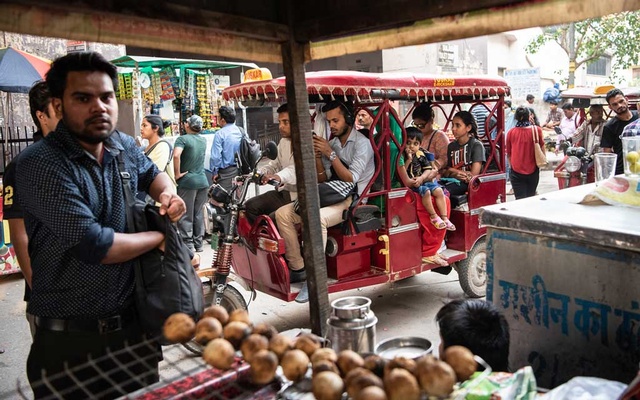By Saumya Khandelwal, Vindu Goel and Karan Deep Singh/ The New York Times
New Delhi, August 24: More than half of the shared three-wheeled electric taxis in India are technically illegal, and the drivers typically don’t have licenses. Accidents are common. Nearly all of the rickshaws are powered by lead-acid batteries underneath the passenger seats. And the electricity used to recharge them is often stolen.
“It isn’t safe at all,” said Suman Deep Kaur, who works at a credit agency and rides an e-rickshaw twice a day between the station and her home. “But this is the only conveyance that will get me home.”
Welcome to the front line of India’s electric vehicle revolution. It’s messy, improvised and driven by the people. The government and vehicle makers are now trying to gain some control over it.
India’s million e-rickshaws make up the second-largest collection of electric vehicles in the world. Only China’s fleet of several hundred million electric motorcycles and bicycles is bigger.
About 60 million Indians hop on an e-rickshaw every day, analysts estimate. Passengers pay about 10 rupees, or 14 cents, for a ride. In a country with limited shared transit options and a vast population of working poor people, the vehicles provide a vital service as well as a decent living for drivers, who are mostly illiterate.
Whirring through Delhi’s side streets and dirt lanes, the e-rickshaws leave passengers with dust-filled lungs and shaken bones. Drivers often go against traffic, playing chicken with oncoming buses and trucks. The vehicles’ open sides, handy for hopping on and off, require that riders hang on or risk falling out. The batteries sometimes overheat, putting people in a literal hot seat.
Yet to millions of Indians, it’s all worth it.
In the country’s northern cities, where e-rickshaws are concentrated, the vehicles are supplanting auto-rickshaws, the better-known three-wheelers that serve as neighbourhood taxis, seat up to three people and run on diesel, gasoline or natural gas.
Although auto-rickshaws are safer and faster, a ride in one costs three to 10 times more than a ride in an e-rickshaw, which is less expensive because of the vehicles’ cheaper energy supply and ability to cram in four or more paying passengers.
For many drivers, going electric is an upgrade from the old-fashioned cycle rickshaws they once pedalled.
Vinod Jha, 42, a cycle rickshaw driver who changed to an electric model two years ago, said that he got more business now. Passengers overwhelmingly prefer e-rickshaws to human-powered ones.

But there are downsides. “I felt healthier then,” he said. “Now I’m lazy.”
India’s embrace of electric vehicles has been disorganised, like so much else in the country. The first e-rickshaws appeared about a decade ago when small manufacturers imported ready-to-assemble kits from China, where the vehicles were used mainly to haul cargo.
The government ignored the rise of e-rickshaws until 2014, when a 3-year-old child was knocked into a pot of hot oil by a driver who hit the boy’s mother. The Delhi High Court ruled that the vehicles were illegal and banned them.
But the national parliament stepped in and legalised e-rickshaws in 2015. Sunny Garg, who runs G&G Automotive, a New Delhi manufacturer of higher-end e-rickshaws that cost about $2,000 apiece, said that elected officials had realised drivers were important constituents.
“One e-rickshaw has at least four to six votes,” he said, referring to the members of each driver’s family.
E-rickshaws reduce air pollution in places like New Delhi, one of the world’s smoggiest cities. Officials there now offer a subsidy of 30,000 rupees, or about $425, to drivers who buy new ones.
As the vehicles’ popularity has grown, Indian companies have tweaked the original Chinese designs. New brands like Saarthi, one of the biggest manufacturers of e-rickshaws in the Delhi area, have emerged, as has an ecosystem of parts suppliers and neighborhood parking lots where drivers can store and recharge their vehicles overnight.
The central government is now trying to force motorcycle and auto-rickshaw makers to go all-electric, too. It just cut taxes on electric vehicles and has proposed subsidies for batteries and charging stations. Along with those carrots is a stick: a requirement that all new three-wheeled vehicles be electric by 2023 and that two-wheeled ones meet that goal by 2025.
“This is good for the Earth,” said Rajiv Kumar, vice-chairman of Niti Aayog, the agency spearheading the plan.
Safety remains a concern. E-rickshaws, with their slow speed and rickety design, are prone to accidents. Drivers are supposed to avoid major roads, but many do not. Utility companies complain about charging lots stealing power using illegal connections.
India’s hot climate also punishes electric batteries. They lose their charge more quickly here than in cooler countries, and they can overheat and shut down.
Big companies are starting to see potential in solving the problems.
Ola, an Uber competitor in India, is experimenting with e-rickshaws that can exchange lithium ion batteries quickly so there is no downtime for drivers. Ola has built a battery-swapping station just outside of Delhi and has raised $250 million from Japanese conglomerate SoftBank to invest in electric vehicle technology.
“It can’t be chaos forever,” said Anand Shah, head of Ola Electric Mobility. “It’s got to improve.”
(Photos by Soumya Khandelwal, The New York Times)



























































